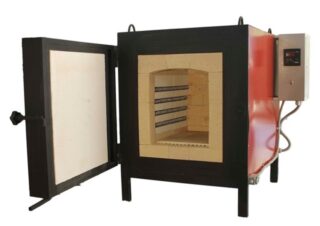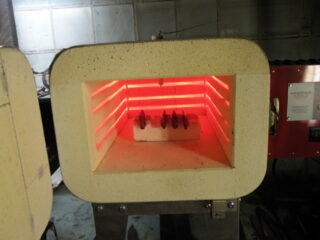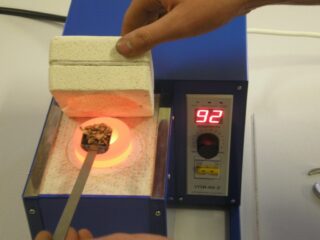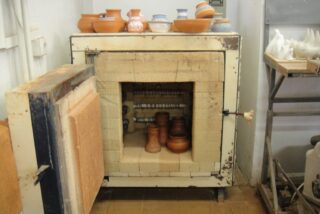A muffle furnace is a special type of heating equipment, usually electrical. Inside there is a casing, called a muffle, that isolates the work area from the heaters. Thanks to this, the parts being processed are protected from the effects of carbon monoxide. If you have special skills, a muffle furnace can be made by hand.
Applications

Such a device is not used for heating a house. It is used in various areas of production and industry. The structure of the furnace creates a favorable environment for saturating the surface of the processed products with chemical elements (for example, chromium or carbon). It is widely used in metal processing - for parts hardening, aging, melting, cyanidation and other operations. The furnace is also used for firing ceramic products and sterilizing medical instruments.
The inner chamber is designed so that uniform heating of the entire working area is created. This ensures that all parts processed in one step are in the same conditions. But high-speed heat treatment in this device is difficult to implement: heating to high temperatures is slow.
Design and principle of operation

The muffle stove has a working chamber inside. The space between it and the outer casing is filled with heat insulating material. Its quality affects the efficiency of the stove and makes it safe to use: the casing does not overheat, as a result of which it is more difficult for the master to get burned. The muffle is made from substances that are chemically inert. Instruments and products to be processed are placed in its chamber.
Heating elements are placed in the walls of the casing or outside it, and their functioning (temperature and duration of action) is controlled by the control unit. The principle of operation is based on the transfer of heat from the heated inner chamber to the area where the workpieces are located.
The casing is a replaceable part: different muffles can be mounted in the furnace casing for certain types of operations. They differ in form and type of loading:
- muffles, in the form of a cap, are installed in the furnace from above;
- simple muffles are loaded from the side;
- the installation of the casing, made in the form of a container, is carried out from above (after heating, it is not separated from the hearth, in contrast to the cap version).
The material of the muffle depends on the conditions for which it is intended. Products from corundum are suitable for use in a chemical environment, from refractory fibers - in a neutral environment. Ceramic structures are inert, therefore they are used in any conditions and for different processes: melting, firing, and others.
Varieties of muffle furnaces

Furnace designs are manufactured for use in various industries. They differ in size and technical parameters. Among the main types are the following:
- The laboratory muffle furnace is used for testing materials - various forms of heat treatment, chemical analyzes. Since such conditions require highly accurate control of temperature conditions, the equipment is supplied with a software control unit.Their heating indicators start from 1100 degrees.
- The jewelry furnace is used for working with precious metals. First of all, raw materials are melted in it. Since jewelers work with small amounts of metals, the oven itself is also small. The linear dimensions of the chamber do not exceed 20 cm. Temperature indicators should be sufficient to melt platinum, silver and other metals.
- The dental oven is used for drying, heating and firing, as well as for sterilizing instruments. Like jewelry, it has a compact size.
- Furnaces for industrial use, on the other hand, are large in size. Often, such units have many auxiliary functions and are able to withstand very high temperatures - 1500 degrees and above. However, operation at values above 1800 degrees helps to accelerate the failure of the heating element.
- A training muffle furnace for roasting and quenching usually has low heating rates (up to 1100 degrees) and compact dimensions.
Stoves can be easy to use and manage and sophisticated. In the second case, the operator can work with the unit, controlling it through a computer. Heating can be carried out in air, vacuum or a special gas (reducing, helium, hydrogen, etc.).
How to choose the right oven

When purchasing a stove, you need to pay attention to the target parameters. To solve each category of tasks, it is necessary to create certain conditions in the chamber.
Permissible loads and temperature modes
The power supply of low-power units (5 kW or less) is realized through a regular household network of 220 V. If the indicator is 6 kW or more, a three-phase 380 V network is required for its operation. To power any stove, a dedicated line is needed, equipped with automatic protection devices purchased specially under it.
Furnaces with low heating rates (up to 900 degrees) are well suited for firing ceramic products. Models with operating values of 1100-1600 degrees are usually used in manufacturing and in laboratories.
Functionality
This concept includes the method of loading raw materials, the dimensions of the stove and its weight, as well as the available special functions related to the peculiarities of temperature control. All these parameters must be suitable for the requirements of the process in which the unit will be involved.
Heating coil and working volume of the chamber
The spiral turns have a diameter of 5-10 mm and are made of wire with a cross section of 2.5-4 mm. The heating element is mounted in the grooves on the walls and fixed with ceramic tubes. The standard volume of the chamber is 10-30 liters. For stoves designed to work with ceramics, it is larger and reaches 200 liters.








